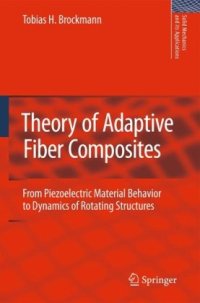
Ebook: Theory of adaptive fiber composites: from piezoelectric material behavior to dynamics of rotating structures
Author: T. H. Brockmann (auth.)
- Genre: Chemistry // Chemical
- Tags: Ceramics Glass Composites Natural Methods, Continuum Mechanics and Mechanics of Materials, Vibration Dynamical Systems Control, Computational Intelligence, Mechanics
- Series: Solid Mechanics and Its Applications 161
- Year: 2009
- Publisher: Springer Netherlands
- City: Dordrecht ; New York
- Edition: 1
- Language: English
- pdf
Adaptive structural systems in conjunction with multifunctional materials facilitate technical solutions with a wide spectrum of applications and a high degree of integration. By virtue of combining the actuation and sensing capabilities of piezoelectric materials with the advantages of fiber composites, the anisotropic constitutive properties may be tailored according to requirements and the failure behavior can be improved. Such adaptive fiber composites are very well-suited for the task of noise and vibration reduction. In this respect, the helicopter rotor system represents a very interesting and widely perceptible field of application. The occurring oscillations can be reduced with the aid of aerodynamic couplings via fast manipulation of the angle of attack, being induced by twist actuation of the rotor blade. On the one hand, the sensing properties may be used to determine the current state of deformation, while, on the other hand, the actuation properties may be used to attain the required state of deformation. The implementation of such concepts requires comprehensive knowledge of the theoretical context, which is illuminated in this work from the examination of the material behavior to the simulation of the rotating structure.
Adaptive structural systems in conjunction with multifunctional materials facilitate technical solutions with a wide spectrum of applications and a high degree of integration. By virtue of combining the actuation and sensing capabilities of piezoelectric materials with the advantages of fiber composites, the anisotropic constitutive properties may be tailored according to requirements and the failure behavior can be improved. Such adaptive fiber composites are very well-suited for the task of noise and vibration reduction. In this respect the helicopter rotor system represents a very interesting and widely perceptible field of application. The occurring oscillations can be reduced with aid of aerodynamic couplings via fast manipulation of the angle of attack, being induced by twist actuation of the rotor blade. On the one hand the sensing properties may be used to determine the current state of deformation, while on the other hand the actuation properties may be used to attain the required state of deformation. The implementation of such concepts requires comprehensive knowledge of the theoretical context, which shall be illuminated in the work at hand from the examination of the material behavior to the simulation of the rotating structure.